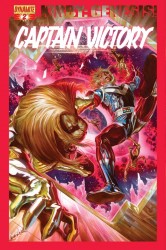![]()
Captain Victory demolished a planet, and now his gunnery officer—a not so cowardly lion-man—is challenging his authority in issue two of this space adventure out of the mind of Jack Kirby!

Captain Victory #2
Story and Script: Sterling Gates
Art Direction and Story: Alex Ross
Art: Wagner Reis
Colors: Inlight Studio
Letters: Simon Bowland
Covers: Alex Ross (A) and Michael Avon Oeming (B)
Publisher: Dynamite Entertainment
Cover Price: $3.99
Previously in Captain Victory: Victory had died, so his body was cloned and his consciousness placed into it. He then proceeded to go back to the battle he had died in, and confronted his former mentor, at which point he authorized the destruction of the entire planet because they had succumbed to the shadow powers of Blackmass (a Darkseid analogue, and the grandfather of Captain Victory).
Dissension in the Ranks
The issue opens with a piece of confusing narration about the origins of the Galactic Rangers, the peacekeeping force Captain Victory is a part of, and the Black Wars in which Blackmass was imprisoned in the dimension known as Quadrant X (because imprisoning evil gods in alternate dimensions always works out so well). I think the narration boxes may have been placed out of order; the one discussing the symbol of the Galactic Rangers, the “Galactic Hand” is placed well in advance of the image of the galactic hand, and refers to it as “their symbol” several text boxes before the rangers are actually mentioned. It’s rather unfortunate that the beginning of this issue is so confusing, as the rest of the book is really well-written.
Captain Victory is a spinoff from the “Kirby Genesis” book where old Jack Kirby characters have been revived and are being handled by some all-star writers. There are a lot of parallels between these characters and later Kirby characters that were created for other companies; the big bad in this book (and, I believe, in the Kirby Genesis title as well) is Blackmass, who is a clear Darkseid equivalent.
In this book we see the fallout from the first issue’s controversial destruction of the planet Kloon and all its inhabitants; the lion-man and gunnery officer Tarin cannot accept Victory’s choice and threatens mutiny. Victory explains his reasoning and tries to persuade Tarin to follow his command at least in the short term, but their discussion is interrupted by an appearance of a Black Eye, some sort of extra-dimensional manifestation of Blackmass which assaults the ship. Captain Victory orders Tarin to attack the eye, Tarin asks the Captain to reconsider and use evasive maneuvers as the ship had already taken a lot of damage in the previous issue. While they argue the Black Eye hits the ship hard, causing a breach in the hull. In the chaos that follows Tarin saves Captain Victory’s life by grabbing him with his tail, and once the hull is resealed (after forty-two crew members were sucked out and vanished along with the Black Eye) Captain Victory apologizes to Tarin for not listening to the advice of one his most trusted men. In the final pages we see a group of crew members come to Tarin and promise him their support if he were to lead a mutiny.
Sterling Gates really captures the nuances of leadership and insubordination in this issue; he has painted us what promises to be a sprawling space opera, and I am looking forward to reading more of what he has to offer.
A Bunch of Stiffs
For as dynamic and active a story as Sterling Gates wrote in this issue, the art by Wagner Reis seems stiff and posed. I haven’t read a lot of Dynamite Entertainment books, so it could be partially the house style or the inking, but my impression was the art felt more like a bunch of action figures than figures in action. The artist also seemed to be trying for a degree of photorealism, which is unsurprising considering Alex Ross is credited as being responsible for the “Art Direction,” but unlike the Kirby Genesis main title the attempt just doesn’t click for me.
BOTTOM LINE: A solid space adventure with a lot of promise!
I enjoyed reading this book a lot, and recommend that anyone who’s a fan of the grandiose cosmic tale or general space adventure story pick it up. The art is decent even though it wasn’t my thing, and the writing is great. You should try to pick up issue one as well, but it’s not absolutely necessary to have read issue one in order to follow this issue. Overall I give it three and a half out of five stars.



